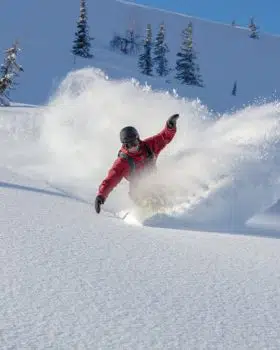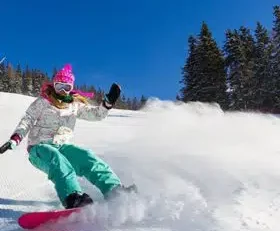Powder Tips for Beginning Snowboarders
Powder snowboarding is the ultimate goal for many snowboarders. There is nothing like the feeling of gliding through untouched powder and the sensation you get when you turn.
But before you go powder hunting, there are a few things you need to know about snowboarding powder. Therefore, we have put together this guide on powder snowboarding, so you can stay safe and have as much fun as possible.
STARTING OUT
The first thing you need to know about snowboarding powder is when to go out. If you have never done it before, you shouldn’t go off into the backcountry looking for fresh lines.
Riding in the backcountry comes with many hazards that require education to avoid. Also, you need to build up your skills before doing anything too adventurous.
Instead, expect to ride powder stashes at the side of the slopes in the resort. These pockets of fresh snow allow you to stay safe and get back to the lifts easily.
If possible, head out on a clear day. You will find snowboarding powder much easier when the visibility is good. Obviously, this isn’t always possible, so choose a low-light goggle lens for cloudy days.
Another way to improve your visibility is to ride near trees. Trees provide contrast, so you can spot imperfections and bumps in the snow much more easily.
THE DAY BEFORE A POWDER DAY
So you have seen the weather forecast, and tomorrow looks like it could be your first powder day. This is the perfect time to tweak your snowboard set up for the morning’s fresh powder. It is good to know how to set up a snowboard for powder riding.
One of the critical things about snowboarding powder is to keep your board’s nose out of the snow. By setting your bindings back slightly, your weight will be towards the tail of your snowboard. This effectively shortens the tail, too; therefore, you don’t have to work as hard to keep your nose above the snow.
Depending on how deep the snow is, you only need to move your bindings back one or two holes.
You may want to service your snowboard in advance. A freshly waxed base will run faster, which is essential for deep snow. Your board’s edges are less of a priority, as they don’t really need to grip in powder.
THE MORNING OF YOUR FIRST POWDER DAY
Get Up Early
The prime time for snowboarding powder is first thing in the morning; therefore, you need to get up early. If you are on the first chair of the day, you will get the first tracks. This is incredibly satisfying, but it is easier too, as the snow won’t be chopped up by other slope users yet.
Prepare Your Body For Snowboarding Powder
It is pretty rare to get a warm-up run in on a powder day. So, it is good to give yourself some time to stretch or do some activation yoga for snowboarding. This will fire up your body and make you feel good, ready for an incredible day on the mountain.
Dress For A Powder Day
When you snowboard powder, you need to dress for the occasion. Make sure you have waterproof outer clothing and wear layers. If you dress appropriately, you will be able to shred pow all day and be comfortable.
Most snowboard jackets have powder skirts. These cinch around your waist or attach to your pants to keep the snow out, keeping you comfortable and dry.
Don’t go overboard with the layers, though, as you will be working hard. If you are too warm, you will find that you will get tired quickly and sweat a lot. Your sweat can make you cold when you’re on the chairlift, so make sure you have a moisture-wicking base layer on!
Don’t Ride Alone
The saying: “No friends on a powder day”, though playfully referencing a skier/ boarder’s snow priority on a pow day, it really should only be used in a tongue-in-cheek way, as you should try to avoid snowboarding in powder alone, especially as a beginner.
While you shouldn’t be doing anything too ambitious at this stage, anyway, it is a good idea to have a buddy with you. If something goes wrong, you can help each other out as well as learn from each other… not to mention snowboarding powder is almost always made better with friends!
THE CORRECT TECHNIQUE FOR RIDING IN POWDER
Keep The Nose Up
You need to be able to keep your board’s nose up and out of the powder while being able to turn. There is a little drill you can do to get a feeling of doing this before heading to your first powder run.
Ride on a groomed slope while leaning over the tail of your snowboard with your shoulders and hips. Make sure you are comfortable in this position but don’t open your leading shoulder. Keep your shoulders in line with your snowboard; if you open your lead shoulder, you will find toe-side turns more challenging.
Riding in this position is an excellent exercise for learning how to turn with the back of your snowboard. Your riding position will depend on how deep the powder is, too. If the snow isn’t too deep, you don’t have to lean back as far—however, deeper snow requires more effort to keep that nose up.
Do this exercise slowly at first and speed it up once you get to grips with this riding position. It is vital to keep your knees bent, keep the movements smooth and not kick your back foot to turn; think like a surfer ????????????
Try implementing this technique in powder when you’ve got it in your muscle memory, and after a couple of practice runs.
Note: You wouldn’t ride like this when going through trees, as you need to make lots of sharp turns, with your weight a little more centered.
So, remember- the main key to riding powder is to shift your weight back, but play around with just how much to lean back. You want to ride on the powder, and still maintain good control in your board!
Speed Is Your Friend
The faster you ride, the easier it is to keep your nose up. Your extra speed will help your snowboard to stay afloat on the snow instead of sinking.
To keep your speed up, you should make “open turns.” These are different turns than you may have been taught in your snowboard lessons.
Instead of completing your turn across the slope, keep your board pointing down the fall line. This way, you will ride faster, but don’t lean too hard into the turn, or your weight will go off-center.
You will find turning much easier when you ride with some speed too. The technique is very similar to surfing, as you push the snow away with your board. But, do beware, the faster you ride, the more effort it takes to stop, especially when the snow is deep.
Be Aware Of Your Surroundings
The best snow is often in remote parts of the mountain. If you are unfamiliar with the mountain, it is a good idea to book a guide or instructor. They will be able to take you to the best spots and keep you safe.
If you decide to head out without a guide, make sure you know what to expect. Heading off to unknown areas can put you at risk from avalanches, crevasses, and a whole host of other dangers. Bursting out of the trees to find yourself at the top of a massive cliff is never a good thing. It is essential to know what you are getting yourself into.
Dangers aside, knowing where you are going will mean you can save your energy for more fun. For example, make sure you stop in appropriate places. If you stop on a flat section, you will have to hike out of waist-deep snow, which will zap your energy extremely quickly.
CONSIDER A SPECIALIST POWDER SNOWBOARD SETUP
A powder snowboard makes your powder day even more fun. These boards are often longer and wider than your regular snowboard (with some exceptions). They also have shorter tails, sometimes with a swallowtail design. This sinks the back of your snowboard, keeping the nose up.
Because of their wide design, back leaning stance, and specific cut, they’ll prove more difficult and less enjoyable to ride in non-pow conditions, but if maximizing your stoke on pow days is a main objective, a powder board is a non-negotiable member to add to your quiver.
GET OUT THERE!
Try out the technique as you read through the instructions above, and get the movements into your body then try it out on the slopes! It will take some practice to perfect the technique, so expect to be rolling around in the snow a lot in the early days. Luckily, falling in powder is usually just as soft and melty as riding it is- so embrace the tumbles, too!
When you do get past the learning curve, though, your powder days will be among the best days of your life.


